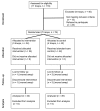A group-randomized controlled trial for health promotion in Girl Scouts: healthier troops in a SNAP (Scouting Nutrition & Activity Program)
- PMID: 20170502
- PMCID: PMC2832775
- DOI: 10.1186/1471-2458-10-81
A group-randomized controlled trial for health promotion in Girl Scouts: healthier troops in a SNAP (Scouting Nutrition & Activity Program)
Abstract
Background: Girl Scouting may offer a viable channel for health promotion and obesity prevention programs. This study evaluated the effectiveness of an intervention program delivered through Girl Scout Junior troops that was designed to foster healthful troop meeting environments and increase obesity prevention behaviors at home.
Methods: Seven Girl Scout troops were randomized to intervention (n = 3, with 34 girls) or standard-care control (n = 4, with 42 girls) conditions. Girls ranged in age from 9 to 13 years (mean 10.5 years). Intervention troop leaders were trained to implement policies promoting physical activity (PA) and healthful eating opportunities at troop meetings, and to implement a curriculum promoting obesity-prevention behaviors at home. The primary outcome variable was child body mass index (BMI) z-score. Secondary outcomes included accelerometer-assessed PA levels in troop meetings, direct observations of snack offerings, time spent in physically active meeting content, and leader encouragement of PA and healthful eating.
Results: The intervention was delivered with good fidelity, and intervention troops provided greater opportunities for healthful eating and PA (x2 = 210.8, p < .001), relative to control troops. In troop meetings, intervention troop leaders promoted PA (x2 = 23.46, p < .001) and healthful eating (x2 = 18.14, p < .001) more frequently, and discouraged healthful eating and PA less frequently (x2 = 9.63, p = .002) compared to control troop leaders. Most effects of the intervention on individual-level variables of girls and parents were not significantly different from the control condition, including the primary outcome of child BMI z-score (F1, 5 = 0.42, p = .544), parent BMI (F1, 5 = 1.58, p = .264), and related behavioral variables. The notable exception was for objectively assessed troop PA, wherein girls in intervention troops accumulated significantly less sedentary (x2 = 6.3, p = .011), significantly more moderate (x2 = 8.2, p = .004), and more moderate-to-vigorous physical activity, (x2 = 18.4, p < .001), than girls in control troops.
Conclusions: Implementing a health promotion curriculum and supporting policies to provide more healthful environments in Girl Scout troop meetings appears feasible on a broader scale. Additional work is needed to bridge health promotion from such settings to other environments if lasting individual-level behavior change and obesity prevention remain targeted outcomes.
Trial registration number: NCT00949637.
Figures
References
-
- Lichtenstein AH, Appel LJ, Brands M, Carnethon M, Daniels S, Franch HA, Franklin B, Kris-Etherton P, Harris WS, Howard B, Njeri Karanja N, Lefevre M, Rudel L, Sacks F, Van Horn L, Winston M, Wylie-Rosett J. Diet and Lifestyle Recommendations Revision 2006: A Scientific Statement From the American Heart Association Nutrition Committee. Circulation. 2006;114(1):82–96. doi: 10.1161/CIRCULATIONAHA.106.176158. - DOI - PubMed
Publication types
MeSH terms
Associated data
LinkOut - more resources
Full Text Sources
Medical



